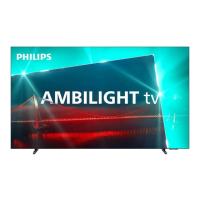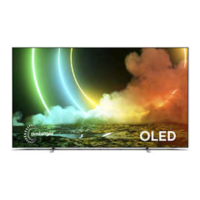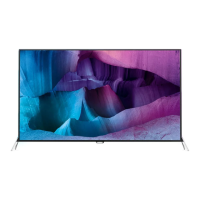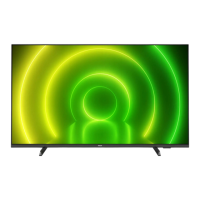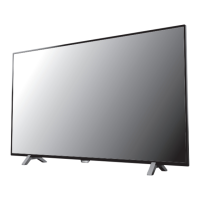Do you have a question about the Philips 48OLED708 and is the answer not in the manual?
Explains the normal and deep refreshing processes for OLED TV screens.
Provides guidelines to prevent image retention and burn-in on OLED displays.
Lists automatic refreshing, brightness control, and screen saver as OLED care features.
Introduces the Google TV home screen as the central hub for content discovery.
Explains how to access the dashboard for settings and device controls.
Differentiates between Google TV and Basic modes, highlighting Google TV features.
Advises reading safety instructions before using the TV.
Guides on installing the TV stand or preparing for wall mounting.
Offers tips for positioning the TV for best viewing and Ambilight effect.
Explains how to connect the power cable and safety precautions.
Details how to connect an antenna for DVB-T/C signals.
Explains how to connect a satellite dish via the SAT connection.
Details the functions of each button on the Type 1 remote control.
Details the functions of each button on the Type 1 remote control.
Details the functions of each button on the Type 2 remote control.
Explains the Bluetooth pairing process for the remote control.
Guides on viewing remote control version and battery level.
Guides on how to use voice search via the remote control.
Identifies the IR sensor location and warns about obstructions.
Covers battery replacement and cleaning instructions for the remote.
Explains how to switch the TV on, put it in standby, and reboot.
Describes how to operate the TV using physical buttons on the unit.
Provides a step-by-step guide for installing satellite channels.
Covers channel packages, Unicable setup, user band numbers, and frequencies.
Explains how to manually update TV channels.
Details manual installation for expert users to add specific channels.
Guides on setting up antenna channels and automatic updates.
Addresses common problems with satellite installation and reception.
Covers manual channel updates, reinstallation, and DVB settings.
Explains how to reset the TV to factory settings.
Details frequency scan, step size, digital/analogue channels, and reception quality checks.
Guides on manually installing analogue TV channels.
Explains how to copy and upload channel lists between TVs.
Provides general information on installing channels.
Explains channel lists, icons, and radio station tuning.
Details how to open and select different channel lists.
Guides on how to search for channels within lists.
Explains how to sort and filter channels by type or status.
Describes how to lock channels to prevent viewing.
Explains how to set age ratings for programmes.
Covers options like screen off, subtitles, and audio language.
Details how to switch subtitles on, off, or set to automatic.
Explains how to enable subtitles for analogue channels manually.
Guides on setting primary and secondary audio languages.
Describes features for hearing, sight, and dialogue enhancement.
Covers settings for HbbTV, tracking, cookies, and app listings.
Explains how to collect and manage favourite channels.
Guides on creating, naming, and populating favourite channel lists.
Details how to add ranges of channels to favourites.
Explains how to rename existing favourite lists.
Guides on how to delete favourite lists.
Explains how to change the order of channels within a favourite list.
Covers options like freezing pages, dual screen, and language.
Guides on setting primary and secondary text languages.
Explains interactive TV features like HbbTV and iTV pages.
Explains how TV guide data is obtained and displayed.
Guides on opening, tuning, viewing details, and changing days in the TV Guide.
Provides guidance on quality connections and cable usage.
Explains how to connect antennas via set-top boxes or recorders.
Discusses HDMI quality, cable recommendations, HDCP, ARC, and eARC.
Explains HDMI ARC and eARC, including requirements and features.
Details how to switch on and use EasyLink for device control.
Explains HDMI Ultra HD settings for optimal signal quality and compatibility.
Guides on connecting HTS via HDMI ARC/eARC.
Offers solutions for sound issues like loud noise or no sound.
Explains how to connect audio systems using the optical output.
Explains how to use CI+ modules for premium HD programs.
Details how to insert the smart card into the CAM module and TV.
Guides on setting up a PIN code for CAM access.
Explains connecting mobile devices via the Philips TV Remote App.
Guides on connecting a Blu-ray player via HDMI.
Details how to connect headphones and adjust volume.
Guides on connecting a game console via HDMI.
Explains how to connect and configure a USB keyboard for text input.
Guides on connecting USB drives for media playback.
Explains viewing Ultra HD photos and videos from USB.
Guides on connecting a camera via USB for photo viewing.
Explains connecting a camcorder via HDMI.
Guides on connecting a computer via HDMI for use as a monitor.
Explains connecting the TV to a home network via Wi-Fi or wired connection.
Details the requirements and steps for wireless network setup.
Outlines the requirements for establishing a wired network connection.
Covers viewing network settings, Wi-Fi (WoWLAN), and Chromecast settings.
Explains the importance of signing into a Google Account for TV features.
Guides on how to start and use the TV's internet browser.
Explains how to switch between connected devices and tuners.
Describes how to quickly access TV functions and settings.
Provides an overview of picture settings and how to adjust them.
Explains how to navigate the picture settings menu and use breakaway menus.
Describes AI picture styles for automatic adjustment.
Explains automatic detection of film content for style adjustment.
Covers light level, dark detail, and colour temperature optimization.
Details contrast, brightness, OLED contrast, and light boost settings.
Explains how to adjust enhancement levels for different picture areas.
Covers HDR tone mapping and HDR effect settings.
Details colour enhancement, temperature, and colour control.
Explains how to adjust the saturation of colours.
Covers sharpness enhancement and texture enhancement.
Details noise reduction and MPEG artefact reduction.
Covers motion styles, smoothness, and fast motion clarity.
Explains film detection and preferred picture style settings.
Guides through a simplified picture setup process.
Explains how to adjust picture format to fill the screen.
Details local image protection, auto pixel shift, and clear residual image.
Guides on selecting sound styles like AI mode, Personal, etc.
Details speaker virtualizer and clear dialogue settings.
Explains how to enable and adjust the AI equalizer.
Guides on adjusting the custom AI equalizer levels.
Advises on placement for best sound reproduction.
Explains DTS Play-Fi for wireless surround sound.
Guides on setting up surround sound with DTS Play-Fi.
Explains setting up a home theater system with Play-Fi speakers.
Explains how Mimi Sound Personalization adapts audio to hearing ability.
Guides on selecting preset surround sound effects.
Explains different sound styles for various content.
Details how to set Dynamic Range Control.
Explains settings for height speaker movement.
Guides on selecting different sound stage experiences.
Explains adjustable frequency bands for custom sound.
Guides on calibrating TV speakers to room acoustics.
Explains how to adjust sound level difference between sources.
Covers enabling or disabling Dolby Atmos notifications.
Explains how to set TV sound output to TV speakers or audio systems.
Details settings for TV speakers, HDMI sound system, and eARC mode.
Explains digital output formats for optical and HDMI ARC.
Details stereo, multichannel, and bypass output formats.
Covers adjusting loudness for HDMI sound systems.
Explains how to adjust audio sync delay for HDMI systems.
Guides on turning Ambilight on or off via remote or settings.
Explains styles like Follow Video, Follow Audio, and Follow Colour.
Details Follow Audio and Follow Colour styles.
Guides on selecting custom colours for static Ambilight.
Explains Ambisleep for unwinding before sleep.
Covers setting the duration for Ambisleep simulation.
Guides on setting the starting brightness for Ambisleep.
Covers selecting light colours for Ambisleep.
Details selecting nature sounds for Ambisleep.
Explains activating Ambilight when the TV is in standby.
Covers brightness, saturation, wall colour, and TV switch-off fade.
Explains tuning and locking warm white colours for Ambilight.
Covers Ambilight+Hue and Philips Wireless Home Speakers integration.
Guides on connecting and configuring wireless home speakers with Ambilight.
Explains how to set up the Sunrise Alarm with Ambilight, music, and weather.
Introduces TV apps and how to install them from the Google Play Store.
Covers renting movies, buying music, and playing games via Google Play.
Details how to download and install new apps from the Google Play Store.
Explains how to hide apps based on maturity levels using PIN codes.
Guides on launching and closing applications on the TV.
Covers stopping apps, clearing cache, and uninstalling unused apps.
Introduces accessibility features for various user needs.
Guides on turning on high contrast text for better readability.
Explains how to convert text into speech for visually impaired users.
Guides on creating quick access to accessibility settings.
Covers system software updates and basic information.
Explains how to update the TV software via Internet or USB.
Details the process of updating TV software using an internet connection.
Guides on updating TV software using a USB flash drive.
Provides information on open source software used in the TV.
Covers how to view current TV software version and details.
Explains how to set the date, time, and time zone.
Guides on selecting the display language for menus and messages.
Covers setting the keyboard layout for installed USB keyboards.
Explains how to check internal storage usage for apps and media.
Details Ambient Mode settings like photo source and slideshow speed.
Covers power-on behaviour and energy saver settings.
Explains how to turn off the screen to save energy.
Guides on setting an automatic timer for the TV to switch to standby.
Details setting an automatic timer to switch off the TV.
Explains how to cast apps from mobile devices using Google Cast.
Covers enabling or disabling system sounds.
Guides on setting and changing the child lock PIN code.
Explains how to set age ratings to lock programmes.
Details settings for shop mode, demo modes, and OLED refreshing.
Guides on pairing, connecting, disconnecting, and renaming Bluetooth devices.
Explains how to pair Bluetooth devices with the TV.
Covers connecting, disconnecting, and renaming paired devices.
Details remote control pairing and information viewing.
Guides on checking and updating remote control software.
Explains how to view media files from a networked computer or NAS.
Guides on adding and viewing favourite media files and folders.
Covers viewing most popular and last played media files.
Guides on playing media files from USB storage devices.
Explains how to open video folders and play videos.
Details options for browsing and playing video files.
Guides on opening photo folders and viewing photos.
Details options for browsing and playing photo files.
Explains how to view and interact with 360-degree photos.
Details options for browsing and playing music files.
Guides on opening music folders and playing music files.
Guides on downloading and using the TV remote app.
Lists requirements for playing games from Google Play or consoles.
Explains how to connect and use gamepads with the TV.
Guides on connecting consoles and computers for gaming.
Explains the gaming control bar for information and settings.
Explains Alexa's capabilities and requirements for TV control.
Guides on setting up and using Alexa for TV control.
Covers energy labels, product disposal, and battery safety.
States the TV's compliance with UK regulations.
Lists power requirements and ambient temperature range.
States the TV's operating system version.
Details aerial and satellite input specifications, tuner bands, and playback formats.
Lists supported computer/video and video-only resolutions and refresh rates.
Details available ports like USB, HDMI, CI+, and antenna connections.
Lists sound output power and supported audio technologies.
Covers supported USB file systems, playback formats, and codecs.
Encourages TV registration for benefits like full support and updates.
Guides on opening the Help menu, searching topics, and using PDF manuals.
Explains how to run TV diagnostics and self-diagnose for troubleshooting.
Addresses issues with the TV not switching on or the remote control.
Provides solutions for no picture, distorted picture, and poor reception.
Offers solutions for no sound or poor sound quality.
Guides on resolving Wi-Fi, Internet, and streaming video issues.
Addresses issues with HDMI devices, USB playback, and network connectivity.
Provides solutions for Bluetooth pairing and connection issues.
Guides on changing the menu language back to the correct one.
Directs users to online support for troubleshooting and information.
Explains how to contact customer support and arrange for repairs.
Provides essential safety instructions to prevent hazards like shock or fire.
Details precautions to prevent electric shock and fire risks.
Covers safe handling, lifting, and mounting procedures to prevent injury or damage.
Warns about TV tip-over hazards and precautions for stable placement.
Provides safety guidelines for handling and disposing of batteries.
Advises on ensuring adequate ventilation to prevent overheating.
Instructs on disconnecting power and antenna during lightning storms.
Warns about using earphones at high volumes or for prolonged periods.
Guides on acclimatizing the TV after exposure to low temperatures.
Explains how humidity might affect the TV and how condensation resolves.
Provides instructions on how to clean and care for the TV screen.
Directs users to view terms of use, privacy policy, and set privacy settings.
Lists copyright information for HDMI.
Provides patent information for HEVC Advance.
Mentions NVIDIA G-SYNC for gaming.
Mentions AMD FreeSync Premium for gaming.
Lists Dolby Vision and Dolby Atmos trademarks.
Provides copyright details for DTS:X audio technology.
Provides copyright details for DTS Play-Fi.
Mentions Wi-Fi CERTIFIED® as a registered trademark.
Mentions Kensington trademarks.
States that other trademarks are property of their respective owners.
Explains the normal and deep refreshing processes for OLED TV screens.
Provides guidelines to prevent image retention and burn-in on OLED displays.
Lists automatic refreshing, brightness control, and screen saver as OLED care features.
Introduces the Google TV home screen as the central hub for content discovery.
Explains how to access the dashboard for settings and device controls.
Differentiates between Google TV and Basic modes, highlighting Google TV features.
Advises reading safety instructions before using the TV.
Guides on installing the TV stand or preparing for wall mounting.
Offers tips for positioning the TV for best viewing and Ambilight effect.
Explains how to connect the power cable and safety precautions.
Details how to connect an antenna for DVB-T/C signals.
Explains how to connect a satellite dish via the SAT connection.
Details the functions of each button on the Type 1 remote control.
Details the functions of each button on the Type 1 remote control.
Details the functions of each button on the Type 2 remote control.
Explains the Bluetooth pairing process for the remote control.
Guides on viewing remote control version and battery level.
Guides on how to use voice search via the remote control.
Identifies the IR sensor location and warns about obstructions.
Covers battery replacement and cleaning instructions for the remote.
Explains how to switch the TV on, put it in standby, and reboot.
Describes how to operate the TV using physical buttons on the unit.
Provides a step-by-step guide for installing satellite channels.
Covers channel packages, Unicable setup, user band numbers, and frequencies.
Explains how to manually update TV channels.
Details manual installation for expert users to add specific channels.
Guides on setting up antenna channels and automatic updates.
Addresses common problems with satellite installation and reception.
Covers manual channel updates, reinstallation, and DVB settings.
Explains how to reset the TV to factory settings.
Details frequency scan, step size, digital/analogue channels, and reception quality checks.
Guides on manually installing analogue TV channels.
Explains how to copy and upload channel lists between TVs.
Provides general information on installing channels.
Explains channel lists, icons, and radio station tuning.
Details how to open and select different channel lists.
Guides on how to search for channels within lists.
Explains how to sort and filter channels by type or status.
Describes how to lock channels to prevent viewing.
Explains how to set age ratings for programmes.
Covers options like screen off, subtitles, and audio language.
Details how to switch subtitles on, off, or set to automatic.
Explains how to enable subtitles for analogue channels manually.
Guides on setting primary and secondary audio languages.
Describes features for hearing, sight, and dialogue enhancement.
Covers settings for HbbTV, tracking, cookies, and app listings.
Explains how to collect and manage favourite channels.
Guides on creating, naming, and populating favourite channel lists.
Details how to add ranges of channels to favourites.
Explains how to rename existing favourite lists.
Guides on how to delete favourite lists.
Explains how to change the order of channels within a favourite list.
Covers options like freezing pages, dual screen, and language.
Guides on setting primary and secondary text languages.
Explains interactive TV features like HbbTV and iTV pages.
Explains how TV guide data is obtained and displayed.
Guides on opening, tuning, viewing details, and changing days in the TV Guide.
Provides guidance on quality connections and cable usage.
Explains how to connect antennas via set-top boxes or recorders.
Discusses HDMI quality, cable recommendations, HDCP, ARC, and eARC.
Explains HDMI ARC and eARC, including requirements and features.
Details how to switch on and use EasyLink for device control.
Explains HDMI Ultra HD settings for optimal signal quality and compatibility.
Guides on connecting HTS via HDMI ARC/eARC.
Offers solutions for sound issues like loud noise or no sound.
Explains how to connect audio systems using the optical output.
Explains how to use CI+ modules for premium HD programs.
Details how to insert the smart card into the CAM module and TV.
Guides on setting up a PIN code for CAM access.
Explains connecting mobile devices via the Philips TV Remote App.
Guides on connecting a Blu-ray player via HDMI.
Details how to connect headphones and adjust volume.
Guides on connecting a game console via HDMI.
Explains how to connect and configure a USB keyboard for text input.
Guides on connecting USB drives for media playback.
Explains viewing Ultra HD photos and videos from USB.
Guides on connecting a camera via USB for photo viewing.
Explains connecting a camcorder via HDMI.
Guides on connecting a computer via HDMI for use as a monitor.
Explains connecting the TV to a home network via Wi-Fi or wired connection.
Details the requirements and steps for wireless network setup.
Outlines the requirements for establishing a wired network connection.
Covers viewing network settings, Wi-Fi (WoWLAN), and Chromecast settings.
Explains the importance of signing into a Google Account for TV features.
Guides on how to start and use the TV's internet browser.
Explains how to switch between connected devices and tuners.
Describes how to quickly access TV functions and settings.
Provides an overview of picture settings and how to adjust them.
Explains how to navigate the picture settings menu and use breakaway menus.
Describes AI picture styles for automatic adjustment.
Explains automatic detection of film content for style adjustment.
Covers light level, dark detail, and colour temperature optimization.
Details contrast, brightness, OLED contrast, and light boost settings.
Explains how to adjust enhancement levels for different picture areas.
Covers HDR tone mapping and HDR effect settings.
Details colour enhancement, temperature, and colour control.
Explains how to adjust the saturation of colours.
Covers sharpness enhancement and texture enhancement.
Details noise reduction and MPEG artefact reduction.
Covers motion styles, smoothness, and fast motion clarity.
Explains film detection and preferred picture style settings.
Guides through a simplified picture setup process.
Explains how to adjust picture format to fill the screen.
Details local image protection, auto pixel shift, and clear residual image.
Guides on selecting sound styles like AI mode, Personal, etc.
Details speaker virtualizer and clear dialogue settings.
Explains how to enable and adjust the AI equalizer.
Guides on adjusting the custom AI equalizer levels.
Advises on placement for best sound reproduction.
Explains DTS Play-Fi for wireless surround sound.
Guides on setting up surround sound with DTS Play-Fi.
Explains setting up a home theater system with Play-Fi speakers.
Explains how Mimi Sound Personalization adapts audio to hearing ability.
Guides on selecting preset surround sound effects.
Explains different sound styles for various content.
Details how to set Dynamic Range Control.
Explains settings for height speaker movement.
Guides on selecting different sound stage experiences.
Explains adjustable frequency bands for custom sound.
Guides on calibrating TV speakers to room acoustics.
Explains how to adjust sound level difference between sources.
Covers enabling or disabling Dolby Atmos notifications.
Explains how to set TV sound output to TV speakers or audio systems.
Details settings for TV speakers, HDMI sound system, and eARC mode.
Explains digital output formats for optical and HDMI ARC.
Details stereo, multichannel, and bypass output formats.
Covers adjusting loudness for HDMI sound systems.
Explains how to adjust audio sync delay for HDMI systems.
Guides on turning Ambilight on or off via remote or settings.
Explains styles like Follow Video, Follow Audio, and Follow Colour.
Details Follow Audio and Follow Colour styles.
Guides on selecting custom colours for static Ambilight.
Explains Ambisleep for unwinding before sleep.
Covers setting the duration for Ambisleep simulation.
Guides on setting the starting brightness for Ambisleep.
Covers selecting light colours for Ambisleep.
Details selecting nature sounds for Ambisleep.
Explains activating Ambilight when the TV is in standby.
Covers brightness, saturation, wall colour, and TV switch-off fade.
Explains tuning and locking warm white colours for Ambilight.
Covers Ambilight+Hue and Philips Wireless Home Speakers integration.
Guides on connecting and configuring wireless home speakers with Ambilight.
Explains how to set up the Sunrise Alarm with Ambilight, music, and weather.
Introduces TV apps and how to install them from the Google Play Store.
Covers renting movies, buying music, and playing games via Google Play.
Details how to download and install new apps from the Google Play Store.
Explains how to hide apps based on maturity levels using PIN codes.
Guides on launching and closing applications on the TV.
Covers stopping apps, clearing cache, and uninstalling unused apps.
Introduces accessibility features for various user needs.
Guides on turning on high contrast text for better readability.
Explains how to convert text into speech for visually impaired users.
Guides on creating quick access to accessibility settings.
Covers system software updates and basic information.
Explains how to update the TV software via Internet or USB.
Details the process of updating TV software using an internet connection.
Guides on updating TV software using a USB flash drive.
Provides information on open source software used in the TV.
Covers how to view current TV software version and details.
Explains how to set the date, time, and time zone.
Guides on selecting the display language for menus and messages.
Covers setting the keyboard layout for installed USB keyboards.
Explains how to check internal storage usage for apps and media.
Details Ambient Mode settings like photo source and slideshow speed.
Covers power-on behaviour and energy saver settings.
Explains how to turn off the screen to save energy.
Guides on setting an automatic timer for the TV to switch to standby.
Details setting an automatic timer to switch off the TV.
Explains how to cast apps from mobile devices using Google Cast.
Covers enabling or disabling system sounds.
Guides on setting and changing the child lock PIN code.
Explains how to set age ratings to lock programmes.
Details settings for shop mode, demo modes, and OLED refreshing.
Guides on pairing, connecting, disconnecting, and renaming Bluetooth devices.
Explains how to pair Bluetooth devices with the TV.
Covers connecting, disconnecting, and renaming paired devices.
Details remote control pairing and information viewing.
Guides on checking and updating remote control software.
Explains how to view media files from a networked computer or NAS.
Guides on adding and viewing favourite media files and folders.
Covers viewing most popular and last played media files.
Guides on playing media files from USB storage devices.
Explains how to open video folders and play videos.
Details options for browsing and playing video files.
Guides on opening photo folders and viewing photos.
Details options for browsing and playing photo files.
Explains how to view and interact with 360-degree photos.
Details options for browsing and playing music files.
Guides on opening music folders and playing music files.
Guides on downloading and using the TV remote app.
Lists requirements for playing games from Google Play or consoles.
Explains how to connect and use gamepads with the TV.
Guides on connecting consoles and computers for gaming.
Explains the gaming control bar for information and settings.
Explains Alexa's capabilities and requirements for TV control.
Guides on setting up and using Alexa for TV control.
Covers energy labels, product disposal, and battery safety.
States the TV's compliance with UK regulations.
Lists power requirements and ambient temperature range.
States the TV's operating system version.
Details aerial and satellite input specifications, tuner bands, and playback formats.
Lists supported computer/video and video-only resolutions and refresh rates.
Details available ports like USB, HDMI, CI+, and antenna connections.
Lists sound output power and supported audio technologies.
Covers supported USB file systems, playback formats, and codecs.
Encourages TV registration for benefits like full support and updates.
Guides on opening the Help menu, searching topics, and using PDF manuals.
Explains how to run TV diagnostics and self-diagnose for troubleshooting.
Addresses issues with the TV not switching on or the remote control.
Provides solutions for no picture, distorted picture, and poor reception.
Offers solutions for no sound or poor sound quality.
Guides on resolving Wi-Fi, Internet, and streaming video issues.
Addresses issues with HDMI devices, USB playback, and network connectivity.
Provides solutions for Bluetooth pairing and connection issues.
Guides on changing the menu language back to the correct one.
Directs users to online support for troubleshooting and information.
Explains how to contact customer support and arrange for repairs.
Provides essential safety instructions to prevent hazards like shock or fire.
Details precautions to prevent electric shock and fire risks.
Covers safe handling, lifting, and mounting procedures to prevent injury or damage.
Warns about TV tip-over hazards and precautions for stable placement.
Provides safety guidelines for handling and disposing of batteries.
Advises on ensuring adequate ventilation to prevent overheating.
Instructs on disconnecting power and antenna during lightning storms.
Warns about using earphones at high volumes or for prolonged periods.
Guides on acclimatizing the TV after exposure to low temperatures.
Explains how humidity might affect the TV and how condensation resolves.
Provides instructions on how to clean and care for the TV screen.
Directs users to view terms of use, privacy policy, and set privacy settings.
Lists copyright information for HDMI.
Provides patent information for HEVC Advance.
Mentions NVIDIA G-SYNC for gaming.
Mentions AMD FreeSync Premium for gaming.
Lists Dolby Vision and Dolby Atmos trademarks.
Provides copyright details for DTS:X audio technology.
Provides copyright details for DTS Play-Fi.
Mentions Wi-Fi CERTIFIED® as a registered trademark.
Mentions Kensington trademarks.
States that other trademarks are property of their respective owners.
| Screen shape | Flat |
|---|---|
| LED backlight | Yes |
| Response time | - ms |
| Display diagonal | 48 \ |
| Display brightness | 900 cd/m² |
| Display technology | QLED |
| Native aspect ratio | 16:9 |
| Native refresh rate | 120 Hz |
| Supported video modes | 576p, 720p, 1080p, 2160p |
| Contrast ratio (typical) | - |
| Display diagonal (metric) | 121 cm |
| Supported graphics resolutions | 640 x 480 (VGA), 1920 x 1080 (HD 1080), 2560 x 1440, 3840 x 2160 |
| Display refresh rates supported | 24 Hz, 25 Hz, 30 Hz, 50 Hz, 60 Hz, 100 Hz, 120 Hz |
| Motion interpolation technology | Perfect Natural Motion |
| Ambient mode | Ambient Mode+ |
| Game features | Auto Low Latency Mode (ALLM) |
| Processor cores | 4 |
| AMD FreeSync type | FreeSync Premium |
| Audio formats supported | AAC, FLAC, MP3, WAV, WMA, WMA-PRO |
| Image formats supported | BMP, GIF, HEIF, JPEG, PNG |
| Video formats supported | AVI, H.264, HEVC/H.265, MKV, MPEG1, MPEG2, MPEG4, VP9 |
| Subtitle formats supported | ASS, SMI, SRT, SSA, SUB, TXT |
| High Dynamic Range (HDR) technology | Dolby Vision, Filmmaker Mode, High Dynamic Range 10+ (HDR10 Plus), Hybrid Log-Gamma (HLG) |
| RF connector type | IEC |
| RF ports quantity | 2 |
| USB 2.0 ports quantity | 3 |
| Ethernet LAN (RJ-45) ports | 1 |
| USB 3.2 Gen 1 (3.1 Gen 1) Type-A ports quantity | 0 |
| Tuner type | Digital |
| Number of tuners | 2 tuner(s) |
| Analog signal format system | Not supported |
| Music apps | Spotify, YouTube Music |
| Video apps | Amazon Prime Video, Apple TV, BBC iPlayer, Disney+, Netflix, YouTube |
| Smart modes | Dolby Vision |
| Operating system installed | Google TV |
| Programming period | 8 day(s) |
| Sound modes | AI Sound, Dialog, Dolby Audio |
| Audio decoders | DTS, Dolby Atmos, Dolby Digital, DTS:X |
| RMS rated power | 40 W |
| Audio output channels | 2.0 channels |
| AC input voltage | 220 - 240 V |
| AC input frequency | 50/60 Hz |
| Energy efficiency scale | A to G |
| Power consumption (standby) | 0.3 W |
| Power consumption (typical) | - W |
| Wi-Fi standards | Wi-Fi 5 (802.11ac) |
| Bluetooth version | 5.0 |
| Stand type | Legs stand |
| Product color | Chrome, Grey |
| Panel mounting interface | 300 x 300 mm |
| Cables included | AC |
| Package depth | 150 mm |
| Package width | 1214 mm |
| Package height | 770 mm |
| Package weight | 17500 g |
| Repairability index | 7.3 |
| Stand width | 783 mm |
|---|---|
| Depth (with stand) | 210 mm |
| Width (with stand) | 1070 mm |
| Height (with stand) | 635 mm |
| Weight (with stand) | 14000 g |
| Depth (without stand) | 58 mm |
| Height (without stand) | 618 mm |
| Weight (without stand) | 13800 g |

